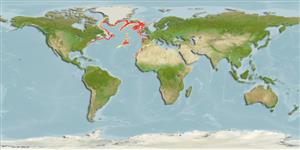>
Perciformes/Zoarcoidei (Eelpouts and pricklebacks) >
Zoarcidae (Eelpouts) > Gymnelinae
Etymology: Melanostigma: Greek, melan, -anos = black + Greek, stigma = signal (Ref. 45335).
Environment: milieu / climate zone / depth range / distribution range
Ecologie
marien bathypelagisch; diepte 400 - 1853 m (Ref. 58426). Deep-water; 74°N - 19°N, 77°W - 6°E
Northwest Atlantic: New Brunswick in Canada to Virginia in USA. Eastern Atlantic: Off the western coast of Scotland and in the Mediterranean (Gulf of Genoa; also off Spain) (Ref. 4695), Faeroe-Iceland Ridge and between Cap Blanc, Mauritania and the Canary Islands (Ref. 6950).
Grootte / Gewicht / Leeftijd
Maturity: Lm ? range ? - ? cm
Max length : 15.0 cm TL mannelijk / geslacht onbekend; (Ref. 7251)
Occurs in midwater over the continental slope. Mostly found from 365-550 m depth, but enters shallower water in the northern part of range (Ref. 7251); prefers salinity of 33.4-34.7 ppt. (Ref. 5951). Bathypelagic (Ref. 58426). Feeds on foraminifera, copepods, and ostracods (Ref. 9731).
Levenscyclus en paargedrag
Maturities | Voortplanting | Spawnings | Egg(s) | Fecundities | Larven
Robins, C.R. and G.C. Ray, 1986. A field guide to Atlantic coast fishes of North America. Houghton Mifflin Company, Boston, U.S.A. 354 p. (Ref. 7251)
Status op de Rode Lijst van het IUCN (Ref. 130435)
Gevaar voor de mens
Harmless
Gebruik door de mens
Tools
Warning: mysqli::__construct(): (HY000/1040): Too many connections in /var/www/html/includes/speciessummary.lib.php on line 2104
Can't connect to MySQL database fbquizv2. Errorcode: Too many connections
